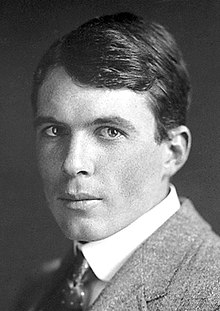Lawrence Bragg

Sir William Lawrence Bragg, CH, OBE, MC, FRS[1] (31 Mac 1890 - 1 Julai 1971) ialah seorang ahli fizik dan pengkristalografi X-ray British kelahiran Australia, penemu (1912) hukum Bragg difraksi sinar-X, yang asas bagi penentuan struktur kristal. Beliau ialah pemenang bersama (bersama bapanya, William Henry Bragg) dari Hadiah Nobel dalam Fizik pada tahun 1915: "Untuk perkhidmatan mereka dalam analisis struktur kristal melalui sinar-X",[2] langkah penting dalam pembangunan kristalografi sinar-X.
Bragg dikurniakan kesatria pada tahun 1941.[3] Pada tahun 2018, beliau ialah pemenang Nobel termuda dalam fizik, setelah menerima penghargaan pada usia 25 tahun.[4] Bragg ialah pengarah Makmal Cavendish, Cambridge, ketika penemuan struktur DNA dilaporkan oleh James D. Watson dan Francis Crick pada Februari 1953.
Rujukan
[sunting | sunting sumber]- ^ Phillips, D. (1979). "William Lawrence Bragg. 31 March 1890-1 July 1971". Biographical Memoirs of Fellows of the Royal Society. 25: 74–143. doi:10.1098/rsbm.1979.0003. JSTOR 769842.
- ^ "The Nobel Prize in Physics 1915". Nobel Foundation. Dicapai pada 2018-04-26.
- ^ "The Nobel Prize in Physics 1915". Nobel Foundation. Dicapai pada 2018-04-26.
- ^ "Facts on the Nobel Prize in Physics". Nobel Foundation. Dicapai pada 16 January 2016.
Bacaan lanjut
[sunting | sunting sumber]Hunter, Graeme. Light Is A Messenger, the Life and Science of William Lawrence Bragg, ISBN 0-19-852921-X; Oxford University Press, 2004.
- John Finch; A Nobel Fellow On Every Floor, Medical Research Council 2008, 381 pp, ISBN 978-1-84046-940-0; (This book is about the MRC Laboratory of Molecular Biology, Cambridge.)
- Ridley, Matt; Francis Crick: Discoverer of the Genetic Code (Eminent Lives), first published in July 2006 in the United States, and then in the UK in September 2006, by HarperCollins Publishers; 192 pp, ISBN 0-06-082333-X (This short book is in the publisher's "Eminent Lives" series).
- John Jenkin: "William and Lawrence Bragg, Father and Son: The Most Extraordinary Collaboration in Science", Oxford University Press, 2008.
Pautan luar
[sunting | sunting sumber] Kategori berkenaan Lawrence Bragg di Wikimedia Commons
Kategori berkenaan Lawrence Bragg di Wikimedia Commons- First press stories on DNA
- Nobelprize.org – The Nobel Prize for Physics in 1915
- Nobel Biography
- A collection of digitised materials related to Bragg's and Linus Pauling's structural chemistry research.
- Key Participants: Sir William Lawrence Bragg – Linus Pauling and the Race for DNA: A Documentary History
- NOVA Episode on Photograph 51
- Oral History interview transcript with William Lawrence Bragg 20 June 1969, American Institute of Physics, Niels Bohr Library and Archives
- Bragg, Lawrence (Sir) (1890–1971) National Library of Australia, Trove, People and Organisation record for William Lawrence Bragg
- The Nature of Things: Oil, Soap and Detergent Diarkibkan 2015-03-16 di Wayback Machine, Ri Channel video, November 1959
- The Nature of Things: Atoms and Molecules Diarkibkan 2014-11-01 di Wayback Machine, Ri Channel video, October 1959
- The Nature of Things: Solids, Liquids and Gases Diarkibkan 2015-03-16 di Wayback Machine, Ri Channel video, November 1959

